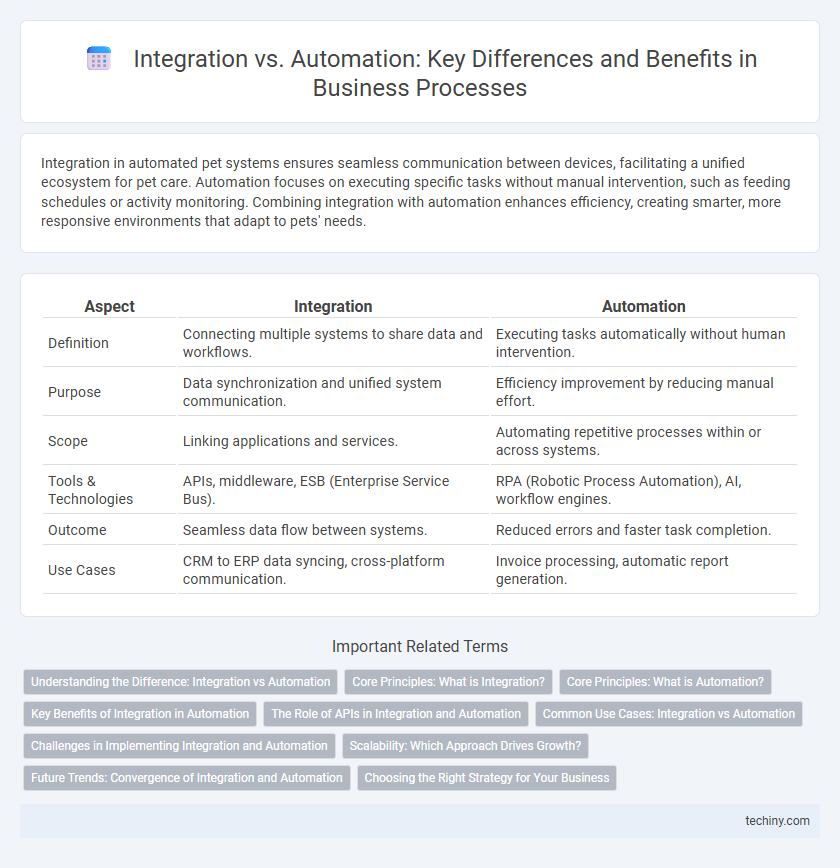Integration in automated pet systems ensures seamless communication between devices, facilitating a unified ecosystem for pet care. Automation focuses on executing specific tasks without manual intervention, such as feeding schedules or activity monitoring. Combining integration with automation enhances efficiency, creating smarter, more responsive environments that adapt to pets' needs.
Table of Comparison
| Aspect | Integration | Automation |
|---|---|---|
| Definition | Connecting multiple systems to share data and workflows. | Executing tasks automatically without human intervention. |
| Purpose | Data synchronization and unified system communication. | Efficiency improvement by reducing manual effort. |
| Scope | Linking applications and services. | Automating repetitive processes within or across systems. |
| Tools & Technologies | APIs, middleware, ESB (Enterprise Service Bus). | RPA (Robotic Process Automation), AI, workflow engines. |
| Outcome | Seamless data flow between systems. | Reduced errors and faster task completion. |
| Use Cases | CRM to ERP data syncing, cross-platform communication. | Invoice processing, automatic report generation. |
Understanding the Difference: Integration vs Automation
Integration connects disparate systems and software to enable seamless data flow and communication, while automation focuses on executing pre-defined tasks without manual intervention. Integration acts as the backbone that unifies various platforms and applications, enhancing interoperability. Automation builds on integration by streamlining workflows, increasing efficiency, and reducing human error through rule-based processes.
Core Principles: What is Integration?
Integration in automation involves connecting disparate systems and software to enable seamless data exchange and unified workflows, ensuring different applications communicate effectively. Core principles emphasize interoperability, real-time data synchronization, and standardized protocols such as APIs or middleware to facilitate process cohesion. Integration serves as the foundation for automation by linking components necessary for orchestrating end-to-end automated tasks.
Core Principles: What is Automation?
Automation involves the use of technology to perform tasks with minimal human intervention, streamlining processes for efficiency and accuracy. Integration connects disparate systems to enable seamless data flow and communication but does not inherently reduce manual effort. Core principles of automation emphasize repeatability, consistency, and scalability in executing predefined tasks to optimize operational performance.
Key Benefits of Integration in Automation
Integration in automation streamlines data flow across systems, enhancing operational efficiency by reducing manual interventions and minimizing errors. It enables real-time communication between disparate software and hardware, facilitating faster decision-making and increased productivity. Key benefits include improved scalability, seamless workflow synchronization, and enhanced data accuracy, which collectively drive optimized business processes.
The Role of APIs in Integration and Automation
APIs act as the crucial connectors in integration and automation, enabling seamless communication and data exchange between disparate software systems. Integration leverages APIs to unify various applications, ensuring coherent workflows, while automation uses APIs to trigger actions and processes without manual intervention. The efficiency and scalability of automation heavily depend on well-designed APIs that facilitate real-time data synchronization and task execution across platforms.
Common Use Cases: Integration vs Automation
Integration connects disparate software systems to enable seamless data exchange, commonly used for syncing customer relationship management (CRM) platforms with marketing tools or linking enterprise resource planning (ERP) systems to inventory management. Automation streamlines repetitive tasks within a single system or process, such as automated email responses, invoice processing, or workflow approvals, boosting efficiency and reducing manual errors. Common use cases highlight integration's role in creating unified data environments, while automation focuses on accelerating operational tasks through rule-based triggers and actions.
Challenges in Implementing Integration and Automation
Implementing integration and automation presents challenges such as data silos, legacy systems compatibility, and complex workflows requiring seamless coordination between disparate platforms. Organizations often face difficulties in aligning automation tools with existing IT infrastructure, ensuring data accuracy, and managing change resistance among employees. Security concerns and the need for scalable, flexible solutions also complicate successful adoption of integration and automation technologies.
Scalability: Which Approach Drives Growth?
Automation drives scalability by enabling systems to perform repetitive tasks with minimal human intervention, boosting efficiency and allowing businesses to handle increasing workloads seamlessly. Integration connects disparate systems for better data flow but often requires manual oversight or additional automation layers to scale effectively. Prioritizing automation strategies promotes sustainable growth by reducing bottlenecks and optimizing resources across expanding operations.
Future Trends: Convergence of Integration and Automation
Future trends in automation emphasize the convergence of integration and automation technologies, creating unified platforms that streamline workflows and enhance efficiency. Intelligent automation combines API-driven integration with machine learning and robotic process automation (RPA) to enable end-to-end process orchestration across disparate systems. This convergence accelerates digital transformation by reducing silos, improving data consistency, and enabling real-time decision-making through advanced analytics.
Choosing the Right Strategy for Your Business
Integration connects disparate software systems to ensure seamless data flow, while automation streamlines repetitive tasks to boost efficiency and reduce errors. Choosing the right strategy depends on business goals, existing infrastructure, and the need for scalability; enterprises with complex workflows benefit from a combined approach that leverages integration for data consistency and automation for operational speed. Evaluating ROI, process complexity, and technology compatibility helps determine whether integration, automation, or a hybrid solution maximizes productivity and supports long-term growth.
Integration vs Automation Infographic

 techiny.com
techiny.com